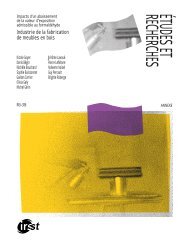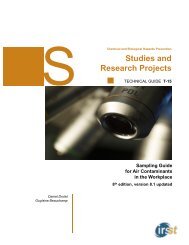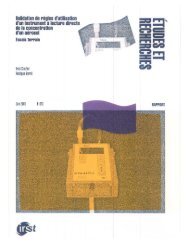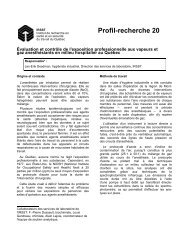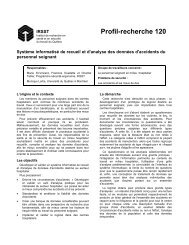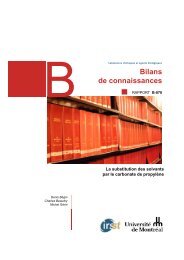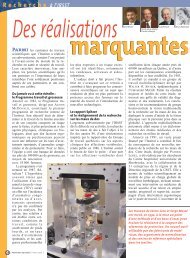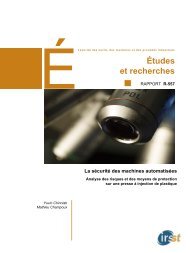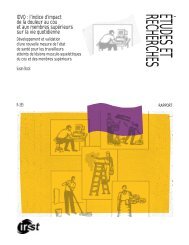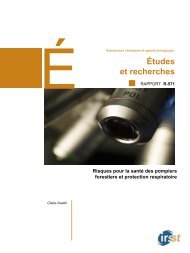HEAVY VEHICLES TIRE BLOWOUT AND EXPLOSION - Irsst
HEAVY VEHICLES TIRE BLOWOUT AND EXPLOSION - Irsst
HEAVY VEHICLES TIRE BLOWOUT AND EXPLOSION - Irsst
You also want an ePaper? Increase the reach of your titles
YUMPU automatically turns print PDFs into web optimized ePapers that Google loves.
Technical fact sheet intended for personnel assigned to heavy vehicle repair and maintenance<br />
Heavy veHicles tire blowout<br />
and explosion<br />
March 2009
Research and writing<br />
René Benoît<br />
Research Department,<br />
Institut de recherche Robert-Sauvé<br />
en santé et en sécurité du travail<br />
(IRSST)<br />
Langis Lafrance<br />
Prevention Consultant, ASTE<br />
Dominique Malo<br />
General Director, ASTE<br />
Julie Baron<br />
Communication Officer, ASTE<br />
This technical fact sheet<br />
is a summary of the research<br />
report* produced by:<br />
René Benoît<br />
Research Department, IRSST<br />
Michel Gou and Olivier Bellavigna<br />
École Polytechnique de Montréal<br />
Toan Vu-Khanh, Patricia Dolez,<br />
Carlos Arrieta, Cédrick Nohilé<br />
and Tung Ha-Anh<br />
École de technologie supérieure<br />
de Montréal<br />
* Exploratory study of heavy<br />
truck tire blowout and explosion<br />
phenomena.<br />
* The document can be consulted<br />
or downloaded free of charge at:<br />
http://www.irsst.qc.ca/files/documents/<br />
PubIRSST/R-479.pdf.<br />
2<br />
table of contents<br />
Introduction .......................................................................................................3<br />
A The phenomenon of tire blowout and explosion .........................................4<br />
A1 Tire blowout of mechanical origin ..........................................................4<br />
a. Over-pressurization of the tire ................................................................4<br />
b. Zipper failure ..........................................................................................4<br />
c. Tire demounting .....................................................................................5<br />
d. Tire in poor condition with a structural weakness ................................5<br />
A2 Tire blowout or explosion following overheating .................................5<br />
Illustration of the phenomenon of tire blowout<br />
or explosion in 4 steps ................................................................................ 6<br />
The consequences .......................................................................................7<br />
B Preventive measures .........................................................................................8<br />
B1 Preventive measures in the repair shop ..................................................8<br />
1. Warnings related to welding or rather intense heating activities<br />
on the wheel, bolts or other components near a tire ............................8<br />
2. Tire that was run at a pressure below 80%<br />
of the recommended pressure ................................................................8<br />
3. Before proceeding to seat the tire ...........................................................8<br />
4. To help seat the tire, use only products recommended<br />
and approved by the manufacturer. .....................................................10<br />
5. Tire inflation .........................................................................................10<br />
Safey cage ..............................................................................................10<br />
6. What should be done when the vehicle is hit by lightning<br />
or an electric arc is produced near or on contact with a high<br />
voltage line? ..........................................................................................11
introduction<br />
D<br />
id you know that in Québec, 360 accidents involving a vehicle<br />
tire occurred over a period of 10 years, including some ten fatal<br />
accidents directly attributable to heavy vehicle tire blowout or<br />
explosion?<br />
Faced with the magnitude of the problem, the ASTE and its partners<br />
(SAAQ, MTQ, ACQ, CSST) asked the Institut de recherche Robert-Sauvé<br />
en santé et en sécurité du travail (IRSST) to study the phenomenon<br />
and to make recommendations.<br />
This fact sheet presents the phenomenon of mechanical blowout of<br />
heavy vehicle tires mounted on wheels, and the process and events that<br />
lead to tire blowout or explosion as a result of heat buildup.<br />
Based on current knowledge, preventive measures are suggested. It must be<br />
emphasized that the best-known preventive measures are those aimed in<br />
particular at personnel who repair and maintain the tires on heavy trucks.<br />
In the case of drivers, the information is rather limited because there are no<br />
objective criteria and very little knowledge about how to identify the hazards,<br />
and even less knowledge about the level of risk. The precaution principle<br />
applies at all times.<br />
3
A<br />
A1 Tire<br />
4<br />
tHe pHenoMenon of tire blowout and explosion<br />
<strong>TIRE</strong> <strong>BLOWOUT</strong> OF MECHANICAL ORIGIN<br />
blowout of mechanical origin involves the condition of the materials (tire, rim) and the quality of<br />
the assembly. While less spectacular than the explosion, the energy released during blowout can lead to<br />
significant injuries if people are directly in the projection trajectory of the debris.<br />
There are four events of a mechanical origin that can cause a tire to blow out. They are:<br />
a. Over-pressurization of the tire:<br />
Possible causes:<br />
n poorly adjusted compressor pressure<br />
n pressure gauge or valve problem<br />
n incorrect mounting on the rim and voluntary over-pressurization when seating the tire on the rim.<br />
b. Zipper failure<br />
A design defect, an overloading or an impact can cause a weakness, a cracking or a rupture of the tire carcass.<br />
The result can lead to significant air loss, the projection of tire fragments, and a sudden drop in pressure<br />
at this location, sometimes accompanied by a mark resembling an unstitched or unzipped fabric.<br />
Reference: Yves Giguère, Training manager,<br />
Eastern region, Goodyear Canada inc.<br />
Reference: Bob Ultrich, “Armed and still dangerous<br />
- Zipper Rates are up. Injuries are down. Here’s why”,<br />
MTD 2001, www.mtdealer.com<br />
Possible causes:<br />
n deterioration of the envelope exposing the plys or the belts of the tire to contamination<br />
by air or humidity<br />
n mechanical impact that damaged the tire’s structure<br />
n driving with underpressurized tire below 80% of the recommended pressure<br />
n driving with overpressurized tires<br />
n overloading<br />
n loss of mechanical properties due to heat, pyrolysis or thermo-oxidation<br />
n significant carcass wear<br />
n design defect in the weave of the tire cord.
A2 When<br />
c. Tire demounting<br />
Tire demounting occurs when the tire accidentally and suddenly comes off the rim with a violent release<br />
of air or other gases from inside the tire.<br />
Possible causes:<br />
n mechanical impact, more or less violent, on the rim or the tire<br />
n abnormal wear of the rim (edge)<br />
n deformation of the rim or one of its components following overheating<br />
n incorrect original mounting of the tire<br />
n incompatible parts of the rim (multi-piece rim)<br />
n dimensional or others incompatibilities of the rim and tire.<br />
d. Tire in poor condition or with a structural weakness<br />
A worn tire or even a new one can have a somewhat noticeable structural defect. It may then be unable<br />
to withstand normal inflation pressure.<br />
<strong>TIRE</strong> <strong>BLOWOUT</strong> OR <strong>EXPLOSION</strong> FOLLOWING OVERHEATING<br />
the temperature inside the tire increases, the pressure inside the tire also increases. This increase<br />
in pressure continues as long as the temperature rises and the tire has not burst or come off the rim.<br />
Also, starting at a certain temperature, different chemical reactions can occur in the tire under the effect<br />
of heat, including thermo-oxidation and pyrolysis.<br />
Pyrolysis is defined as the irreversible chemical decomposition of a material under the sole action of heat.<br />
In the case of a tire, degradation of the rubber takes place. This phenomenon occurs:<br />
n when the temperature inside the tire reaches 185°C<br />
n in the absence of oxygen (inflation with nitrogen does not eliminate the phenomenon of pyrolysis)<br />
n in a few seconds.<br />
Also, this phenomenon leads to a degradation of the tire’s chemical and mechanical properties, which<br />
can occur gradually and whose effects can be cumulative following several overheating events.<br />
With thermo-oxidation, which can occur in the presence of oxygen, the signs are practically the same,<br />
except that thermo-oxidation does not occur if inflation with nitrogen.<br />
The gases produced by pyrolysis and thermo-oxidation cause an increase in pressure in the tire,<br />
which can lead to blowout.<br />
However, if the three following critical conditions occur simultaneously:<br />
n sufficient concentration of flammable gas<br />
n temperature and pressure equal to or greater than the auto-ignition temperature and pressure<br />
of the gases<br />
n oxygen concentration above 5.5%.<br />
A violent explosion occurs in which the pressures at the time of the explosion are in the order of 1000 psi<br />
or more, with the production of shock waves.<br />
5
ILLUSTRATION OF THE PHENOMENON OF <strong>TIRE</strong> <strong>BLOWOUT</strong> OR <strong>EXPLOSION</strong> IN 4 STEPS<br />
6<br />
INTERNAL<br />
PRESSURE Pi<br />
OF THE <strong>TIRE</strong><br />
HEAT TRANSMITTED TO THE <strong>TIRE</strong><br />
INTERNAL<br />
PRESSURE Pi<br />
OF THE <strong>TIRE</strong><br />
INCREASING TEMPERATURE<br />
HEAT TRANSMITTED TO THE <strong>TIRE</strong><br />
INTERNAL<br />
PRESSURE Pi<br />
OF THE <strong>TIRE</strong><br />
INCREASING TEMPERATURE<br />
HEAT TRANSMITTED TO THE <strong>TIRE</strong><br />
INTERNAL<br />
PRESSURE Pi<br />
OF THE <strong>TIRE</strong><br />
EXTREMELY RAPID<br />
INCREASE IN Pi<br />
INTERNAL<br />
PRESSURE Pi<br />
OF THE <strong>TIRE</strong><br />
THERMAL EXPANSION<br />
INITIATION OF CHEMICAL REACTIONS<br />
PRODUCTION OF FLAMMABLE GASES + MATERIALS<br />
� COMBINATION OF CRITICAL CONDITIONS<br />
TEMPERATURE + GAS CONCENTRATION +<br />
PRESENCE OF OXYGEN<br />
VERY RAPID<br />
INCREASE IN Pi<br />
INTERNAL<br />
PRESSURE Pi<br />
OF THE <strong>TIRE</strong><br />
THERMAL EXPANSION<br />
INITIATION OF CHEMICAL REACTIONS<br />
� PRODUCTION OF FLAMMABLE GASES +<br />
MATERIALS<br />
GRADUAL<br />
INCREASE OF Pi<br />
INTERNAL<br />
PRESSURE Pi<br />
OF THE <strong>TIRE</strong><br />
THERMAL EXPANSION<br />
� INITIATION OF CHEMICAL REACTIONS<br />
INCREASING TEMPERATURE<br />
GRADUAL<br />
INCREASE OF Pi<br />
INTERNAL<br />
PRESSURE Pi<br />
OF THE <strong>TIRE</strong><br />
HEAT TRANSMITTED TO THE <strong>TIRE</strong><br />
� THERMAL EXPANSION<br />
INCREASING TEMPERATURE<br />
4<br />
3<br />
2<br />
1<br />
When the critical concentration of<br />
flammable gases and materials is<br />
reached in the presence of oxygen<br />
at auto-ignition temperature and<br />
pressure : explosion occurs.<br />
If the heat buildup continues,<br />
the accumulation of flammable gases<br />
and materials due to degradation of<br />
the rubber continues.<br />
When heated to around 185°C<br />
(this temperature may correspond<br />
to air temperatures in the tire as<br />
low as 100°C), the rubber begins to<br />
degrade, producing flammable gases<br />
and materials, further increasing<br />
the pressure in the tire: risk of tire<br />
blowout.<br />
Heating of the air in the tire, which<br />
expands and causes an increase in<br />
pressure: risk of tire blowout.<br />
SOURCES OF HEAT<br />
■ Locked brake, defective bearing, excessive braking<br />
■ Roadway temperature, lightning, electric arc, welding, fire, etc.<br />
■ Under-inflation of the tire<br />
■ Overloading of the tire, excessive speed, etc.<br />
If the heat is sufficiently intense to reach step 3, and the tire does not cool down, and the heat continues to be transmitted to the tire;<br />
the time to reach step 4, where the risk of explosion is significant, can vary from a few minutes to more than one hour.
The consequences<br />
In the event of blowout or explosion, the violent blast or the projection of fragments can cause serious and<br />
even fatal injuries to anyone who is nearby. Photo no. 1 shows a burst tire that resulted in the worker’s<br />
death. Photo no. 2 shows a tire that burst following the initiation of an electric arc produced when a flatbed<br />
semitrailer was parked near a high voltage line.<br />
Photo no. 1: Example of a tire that burst following<br />
brake overheating (locked brakes).<br />
Photo no. 2:<br />
Tire that burst,<br />
semi-trailer hit<br />
by an electric arc<br />
near a high voltage<br />
line.<br />
Unfortunately, there are few or no reliable objective signs that are easily measurable or even apparent<br />
that can be used to detect the start or significance of the rubber’s degradation under the effect of the heat<br />
originating from different sources, such as:<br />
1. overheating of the brakes (complete or partial locking, or excessive use)<br />
2. electric arc (lightning, contact with or proximity to high voltage lines)<br />
3. vehicle on fire<br />
4. welding of the rim with a tire mounted on it<br />
5. welding or heating with a torch of a part near the rim with a tire mounted on it<br />
6. use of under-pressurized tires<br />
7. use when overloaded<br />
8. use at excessive speeds<br />
9. very high roadway temperature<br />
10. unequal pressures on tires mounted on double wheels<br />
11. friction of an object (e.g., vehicle body part, bumper) on the tire<br />
12. contact of tires in a double wheel assembly<br />
13. any combination of these different sources of heat.<br />
7
B Preventive<br />
8<br />
preventive Measures<br />
measures are essentially based on the current knowledge available and on the precautionary<br />
principle, due to the importance of the consequences for people when the tire blows out or explodes.<br />
B1<br />
PREVENTIVE MEASURES IN THE REPAIR SHOP<br />
1. Warnings related to welding or rather intense heating activities on the wheel, bolts or other<br />
components near a tire:<br />
n Formal prohibition to weld on the rim or on one of the wheel components.<br />
n Prohibition to weld near or on a component likely to transmit the heat to the rim or to the tire when<br />
the tire is mounted. It is recommended that the wheel be demounted under such circumstances.<br />
n In exceptional cases in which there is no other solution than heating near the rim in order, for example,<br />
to thaw components or to loosen bolts, it is imperative that the tire be completely deflated and unseated<br />
from the rim before using the source of heat. In fact, it is vital to know that the hazard is not necessarily<br />
eliminated by deflating the tire (the heat captured inside the tire can lead to degradation of the<br />
rubber).<br />
The tire, rim and components must be cooled to ambient temperature before proceeding with any eventual<br />
reseating of the tires. Also, tires must never be reseated or inflated without first carefully examining them<br />
and the wheel for any sign of degradation. However, this is a minimum precaution. Any other alternative<br />
to heating should always be used in all cases.<br />
n Steps to be followed when heating cannot be avoided:<br />
— deflate and unseat the tire or tires from the rim<br />
— do the repair<br />
— let cool to ambient temperature<br />
— inspect the rim and tire for any sign of degradation.<br />
2. Tire that was run at a pressure below 80% of the recommended pressure<br />
Attention! For numerous heavy vehicles, trucks and semi-trailers, the maximum recommended pressure for<br />
the most common tires is generally 100 psi. It is therefore important that heavy vehicle repair and maintenance<br />
personnel pay particular attention to all tires inflated to 80 psi or less.<br />
Do not reinflate the tire; the tire may have overheated or deteriorated. It must be demounted in order to<br />
properly examine it.<br />
3. Before proceeding to seat the tire:<br />
Always check for signs of fatigue on the tire in order to avoid the phenomenon of blowout associated<br />
with zipper failure.<br />
n Examples of observable elements:<br />
— check for the presence of marbling (black lines around the inside circumference of the sidewalls)<br />
— check for the presence of signs of separation or deformation of the liner inside the tire<br />
— check for the presence of carbon dust originating from the destruction of the liner<br />
— check carefully the sidewalls of the tire to detect any distortion, cracks, small breaks, cracking,<br />
exposed steel cord, discoloration, irregular bulging or warping, soft or more flexible spot.<br />
If in doubt, the tire must be discarded.
Source: Kevin Rohlwing, “Identifying a Zipper Rupture,” ITRA (International Tire & Rubber Association Foundation, Inc.)<br />
Commercial Tire Service Update, Volume 5, Issue 11, November 2000.<br />
n Always inspect the rim:<br />
— the general condition (sign of impact, crack, sign of overheating)<br />
— the geometry (radial and lateral rim run-out, deformed)<br />
— sign of wear.<br />
If the rim flange seems deformed or worn, make sure that it complies with the manufacturer’s rating<br />
and tolerances or have it inspected by experts.<br />
Reference: The Maintenance Council (TMC), 2001. Recommended Maintenance Practices Manual, 2000-2001. Council of ATA.<br />
RP 205A-1, RP 209C-1, RP 222A-22 & 39, RP 228-1, RP 232-1.<br />
n Never mount a tire on a:<br />
— cracked rim<br />
— rim in poor condition (wear, corrosion, deformed lug holes, off-true rim)<br />
— rim that has been heated significantly (fire or quasi-fire).<br />
9
10<br />
4. To help seat the tire, use only products recommended and approved by the manufacturer.<br />
Never use a lubricant or an adhesive containing flammable materials when mounting.<br />
n According to “The Maintenance Council (TMC), Recommended Maintenance Practices Manual, article<br />
RP 205A,” the lubricants recommended for the bead for seating a truck tire (in water solution) are:<br />
— vegetable oil soaps<br />
— animal soaps.<br />
n To be completely avoided:<br />
— petroleum-product-based oils or greases (may affect the properties of the rubber and create<br />
an explosive volatile mixture)<br />
— solvent-based lubricants (may create an explosive volatile mixture)<br />
— silicone-based oils (may cause eventual slipping of the bead).<br />
5. Tire inflation<br />
To avoid all risks of accidents and injuries when inflating tires, the following precautions must be taken:<br />
n Place the wheel in a safety cage<br />
n Always use a clip-on air chuck with air hose extension equipped with a control valve and a pressure gauge<br />
n Maintain a safe distance (approximately 2 m) between the worker and the tire to be inflated. The worker<br />
should never stand facing the wheel but instead stand to the side so as to be facing the tread (see below).<br />
The majority of safety cages available on the market are designed to prevent the projection of components<br />
of a multi-piece rim. However, they do not protect the worker in the event of sudden rupture or demounting<br />
when bursts or particulates can be projected.<br />
The Association Sectorielle Services Automobiles (ASP Auto Prévention) participated in the design of a safety<br />
cage that controls not only the risks of separation of a multi-piece rim, but also the risks related to sudden<br />
rupture and all other types of accidents that can occur during tire inflation, regardless of the type of rim. As<br />
the plans below illustrate, this cage completely surrounds the tire and protects the workers, regardless of the<br />
type of rupture.<br />
You can obtain the design plan for the safety cage at the following address:<br />
http://autoprevention.qc.ca/docs/AP_2005-12-complet.pdf<br />
Projection danger zone during tire inflation.<br />
Reference: http://www2.worksafebc.com/media/fss/tire/slideshow.htm
Truck tire blowout in a safety cage.<br />
Three sequences of tire blowout with projection of the rim in a safety cage.<br />
On the photograph at the left, you can see the trajectory<br />
that the debris may take following tire blowout.<br />
On the photographs below, we see that the energy<br />
released during blowout deforms the safety cage, as well<br />
as moving it and rotating it. It is important that the<br />
worker stay outside the trajectory of the debris and far<br />
enough away from the cage so as not to be injured by it.<br />
Reference : http://www.kentool.com/demos/cage_demo.mpg<br />
6. What should be done when the vehicle is hit by lightning or an electric arc is produced near<br />
or on contact with a high voltage line?<br />
The current state of knowledge and the data available do not allow clear and precise information to be<br />
provided on the indications and the precursor signs that would allow detection and estimation of the<br />
danger and risk level.<br />
However, by applying the precautionary principle, some rules or guidelines can be applied to reduce the risk.<br />
n Be aware that:<br />
— there is a risk of electrocution for the driver, particularly when he gets out of the vehicle. This risk is<br />
just as significant for those who could come to assist the driver (see note below)<br />
— the tires are at high risk of blowout or even explosion<br />
— this risk persists even if the source of electrical energy is completely eliminated<br />
— the explosion can occur several hours after the incident.<br />
n If lightning or an electric arc hits a vehicle, its tires can explode. The risk of explosion is even<br />
greater if the lightning or the electric arc causes obvious material damage to the vehicle. In the<br />
documentation consulted, a quarantine period of at least 24 hours is recommended.<br />
n In some cases, there are no visible signs. Nevertheless, the risk remains just as significant and the same<br />
recommendations apply.<br />
NOTE: The driver must absolutely avoid making contact between the ground and the vehicle.<br />
For example, in the case of fire, he would have no other choice but to jump from the vehicle with<br />
his feet together, by avoiding touching the body of the vehicle. Once on the ground, he should<br />
get as far away as possible by jumping with his feet together as recommended by the specialists (*),<br />
and warn emergency services.<br />
* Reference: Course LEL2400 – Électricité : Sécurité et environnement at the École Polytechnique de Montréal<br />
11
6455, rue Jean-Talon Est, bureau 301<br />
Montréal (Québec)<br />
H1S 3E8<br />
Tel. : 514 955-0454 or 1-800-361-8906<br />
Fax : 514 955-0449<br />
info@aste.qc.ca<br />
www.aste.qc.ca<br />
505, boul. de Maisonneuve Ouest<br />
Montréal (Québec)<br />
H3A 3C2<br />
Tel. : 514 288-1551<br />
publications@irsst.qc.ca<br />
www.irsst.qc.ca



